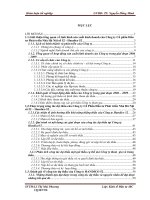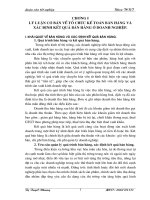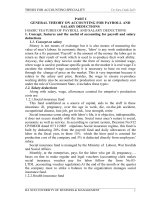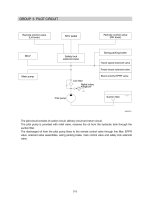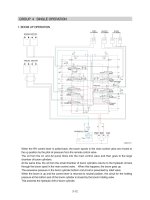Slides – Accounting Intake 52
Bạn đang xem bản rút gọn của tài liệu. Xem và tải ngay bản đầy đủ của tài liệu tại đây (903.05 KB, 13 trang )
<span class='text_page_counter'>(1)</span><div class='page_container' data-page=1>
<i><b>Copyright © 2009 by The McGraw-Hill Companies, Inc. All rights reserved.</b></i>
<i><b>McGraw-Hill/Irwin</b></i>
<b>Statement </b>
<b>Analysis</b>
</div>
<span class='text_page_counter'>(2)</span><div class='page_container' data-page=2>
3&4
<b>CHAPTER</b>
</div>
<span class='text_page_counter'>(3)</span><div class='page_container' data-page=3>
<b>Balance Sheet</b>
<sub> Express an entity’s financial position at a point in </sub>
time in terms of:
</div>
<span class='text_page_counter'>(4)</span><div class='page_container' data-page=4>
<b>Purposes of Balance sheet</b>
<sub> To help users answer:</sub>
<sub>Does the company have enough assets to pay </sub>
debts ?
<sub>What is the company’s value ?</sub>
</div>
<span class='text_page_counter'>(5)</span><div class='page_container' data-page=5>
<b>ASSETS</b>
<sub>“Resourses controlled by a company for the </sub>
purpose of generating profit”
<sub>Classification based on the convertibility to cash</sub>
<sub>Current (Short-term) assets</sub>
</div>
<span class='text_page_counter'>(6)</span><div class='page_container' data-page=6>
<b>Current (Short-term) </b>
<b>Assets</b>
<b>Current (Short-term) </b>
<b>Assets</b>
<b>Noncurrent (Long-</b>
<b><sub>term) Assets</sub></b>
<b>Noncurrent </b>
<b>(Long-term) Assets</b>
Resources or claims to
resources that are
expected to be sold,
collected, or used within
one year or the operating
cycle, whichever is longer.
Resources or claims to
resources that are
expected to be sold,
collected, or used within
one year or the operating
cycle, whichever is longer.
Resources or claims to
resources that are
expected to yield benefits
that extend beyond one
year or the operating
cycle, whichever is
longer.
Resources or claims to
resources that are
expected to yield benefits
that extend beyond one
year or the operating
cycle, whichever is
longer.
</div>
<span class='text_page_counter'>(7)</span><div class='page_container' data-page=7>
<b>Current assets</b>
• Cash & cash equivalents
• Marketable securities
• Receivables
• Inventories
• Prepaid expenses
</div>
<span class='text_page_counter'>(8)</span><div class='page_container' data-page=8>
Three step process:
(1) Reported LIFO Inventory + LIFO reserve
(2) Deferred tax payable + [LIFO reserve x Tax rate]
(3) Retained earnings + [LIFO reserve x (1-Tax rate)]
LIFO reserve is the amount by which current cost exceeds
reported cost of LIFO
inventories
Three step process:
(1) Reported LIFO Inventory + LIFO reserve
(2) Deferred tax payable + [LIFO reserve x Tax rate]
(3) Retained earnings + [LIFO reserve x (1-Tax rate)]
LIFO reserve is the amount by which current cost exceeds
reported cost of LIFO
inventories
</div>
<span class='text_page_counter'>(9)</span><div class='page_container' data-page=9>
<i> Illustration 4.2 (page 233)</i>
Campbell’s Soup reports “adjustments of inventories to LIFO basis” (the
LIFO reserve) are $89.6m in year 11 and $84.6m in year 10. The income
tax rate is 34%. Restate Campbell’s financial statements from LIFO to
FIFO.
<i> Illustration 4.2 (page 233)</i>
Campbell’s Soup reports “adjustments of inventories to LIFO basis” (the
LIFO reserve) are $89.6m in year 11 and $84.6m in year 10. The income
tax rate is 34%. Restate Campbell’s financial statements from LIFO to
FIFO.
</div>
<span class='text_page_counter'>(10)</span><div class='page_container' data-page=10>
<b>Long-term assets</b>
<sub>Investments</sub>
<sub>Tangible fixed assets (Property, plant & </sub>
Equipments)
<sub>Intangible assets (i.e. patents, copyrights, </sub>
trademarks, goodwill)
<sub>Financial leases</sub>
<sub>Deffered charges</sub>
</div>
<span class='text_page_counter'>(11)</span><div class='page_container' data-page=11>
<b> LIABILITIES</b>
• “an <i>obligation</i> of an entity arising
from <i>past</i> transactions or events, the settlement of
which is expected to result in an <i>outflow</i> from the
enterprise of resources embodying economic
benefits.
• Classification based on time of payment.
</div>
<span class='text_page_counter'>(12)</span><div class='page_container' data-page=12>
<b> EQUITY</b>
<sub>“the claims of owners on the net assets of the </sub>
company (ownership in total assets after all liabilities
associated are paid off).”
<sub>Including:</sub>
<sub>Common stock / Preferred stock</sub>
<sub>Paid-in capital (Additional paid-in capital or </sub>
contributed capital)
</div>
<span class='text_page_counter'>(13)</span><div class='page_container' data-page=13>
<b> </b>
<b>WHO IS WHO?</b>
</div>
<!--links-->
